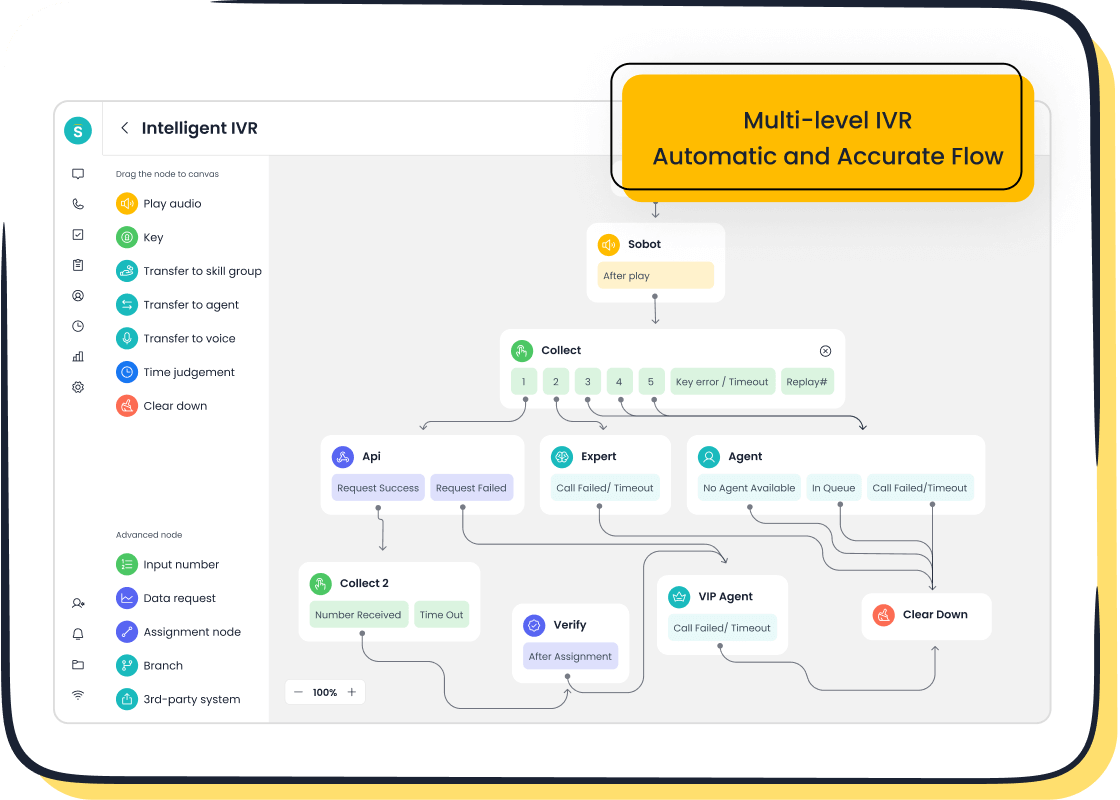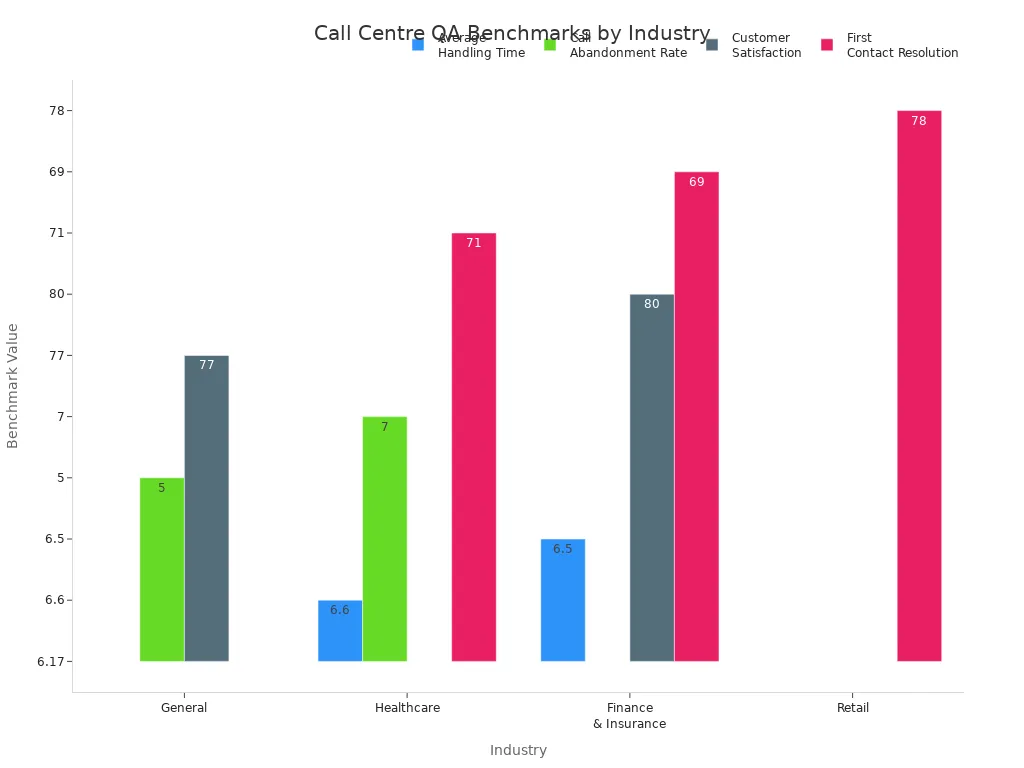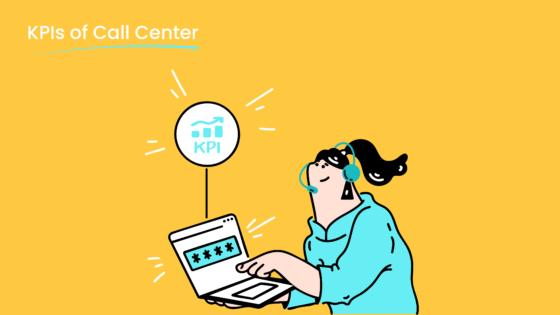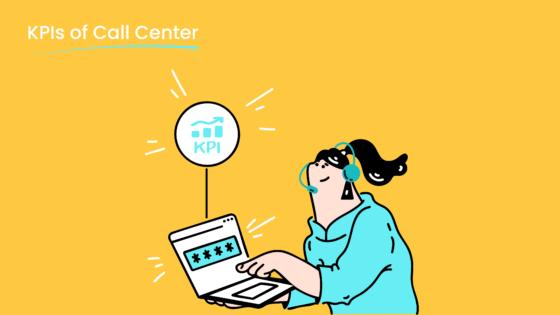Understanding Call Centre Quality Assurance Frameworks

A call centre quality assurance framework helps you monitor, measure, and improve every customer interaction. You use it to set service standards, track key metrics like customer satisfaction, and ensure your team meets business goals. When you apply a strong framework, you see higher satisfaction scores, better agent performance, and more efficient operations. For example, benchmarks show top-performing centers achieve CSAT scores above 77% and handle calls in about six minutes.

Sobot leads the way with Sobot AI and Sobot call center solutions that help you build a culture of continuous improvement.
What Is Call Centre Quality Assurance?

Call centre quality assurance is a structured approach you use to evaluate and improve customer interactions within your contact center. This process ensures every customer service call meets your company’s standards and supports your customer service goals. When you implement a quality assurance program, you create a consistent experience for your customers and help your agents perform at their best.
Key Elements
A strong call centre quality assurance framework includes several essential components:
- Clear Standards and Guidelines: You set expectations for how agents should handle customer interactions. These standards cover tone, accuracy, compliance, and problem-solving.
- Call Monitoring: You regularly review live or recorded calls to assess agent performance and identify areas for improvement.
- Scoring and Feedback: You use scorecards to rate calls and provide actionable feedback to agents. This helps agents understand what they do well and where they can improve.
- Training and Coaching: You offer targeted training based on quality assurance findings. This supports continuous development and aligns with your customer service goals.
- Data Analysis: You track trends and patterns in customer interactions. This allows you to adjust your quality assurance program and address recurring issues.

Tip: Using a unified workspace, like Sobot’s Voice/Call Center, helps you streamline the quality assurance process by centralizing call data and agent performance metrics.
Success Metrics
You measure the effectiveness of your call center quality assurance efforts using specific metrics. These metrics help you understand how well your team meets business objectives and delivers high-quality service. Common metrics include:
- Average Speed of Answering (ASA)
- First Call Resolution (FCR)
- Average Handle Time (AHT)
- Customer Satisfaction Score (CSAT)
- Net Promoter Score (NPS)
- Customer Effort Score (CES)
First Call Resolution stands out as a critical metric. It measures the percentage of customer issues resolved in a single interaction, without callbacks or escalations. Industry leaders achieve FCR rates above 85%, which leads to higher customer satisfaction and lower operational costs. You also track agent performance, compliance, and total QA scores to benchmark progress and guide coaching. By focusing on these metrics, you ensure your quality assurance program drives real improvements in customer service calls and overall business outcomes.
Why Quality Assurance Matters

Customer Experience
You shape customer experience every time your agents answer a call. Call center quality assurance sets clear customer satisfaction standards and guides agents to deliver consistent service. When you monitor agent performance and provide feedback, you help agents resolve issues quickly and accurately. This process builds trust and increases satisfaction.
Quality assurance directly influences customer experience metrics such as Net Promoter Score (NPS). High QA scores show that agents follow protocols and resolve problems effectively. Customers feel valued and are more likely to recommend your service. You can see this impact in several ways:
- Agents who receive targeted training based on QA insights improve their communication and problem-solving skills.
- Continuous monitoring and feedback loops help agents maintain high satisfaction levels.
- Analyzing QA and NPS data together lets you identify strengths and weaknesses, so you can make targeted improvements.
- Addressing common pain points creates a more customer-friendly environment, boosting satisfaction and loyalty.
Sobot’s Voice/Call Center solution supports these efforts by providing real-time monitoring and unified workspaces. You gain actionable insights into customer interactions, helping you meet customer satisfaction standards and elevate call center performance.
Business Impact
Call center quality assurance drives measurable business outcomes. When you focus on first contact resolution, you retain more customers. Research shows that 61% of consumers expect their issues resolved on the first call, or they consider switching to competitors (source). Improving FCR reduces operational costs and increases retention.
AI-powered conversation intelligence tools, like those in Sobot’s platform, analyze every interaction. You identify root causes of poor FCR and coach agents for better results. Personalization, driven by QA insights, increases loyalty. Brands that excel in personalization are 71% more likely to report improved loyalty (source). Automated reviews and comprehensive QA help you maintain consistent service quality and operational efficiency.
You benefit from higher customer satisfaction, increased spend, more referrals, and stronger brand reputation. Continuous improvement in call center performance leads to sustainable growth and long-term success.
Challenges in Call Center Quality Assurance
Common Obstacles
You face several challenges when you implement a call centre quality assurance framework. These obstacles can slow progress and impact your results. The most frequently reported issues include:
- Time Pressure: You often need to deliver time-critical tasks, which limits the time available for quality assurance activities.
- Agent Resistance: Agents may push back against new processes. They can feel stressed by increased performance monitoring and fear change.
- Training Gaps: Outdated training materials and a lack of resources make it hard to teach staff about new analytics tools and software.
Sobot customers, such as Weee!, have experienced these same challenges. Weee! struggled with inflexible IVR systems and language barriers, which made it difficult to maintain consistent service quality. Their agents also faced stress from switching between multiple systems and managing high call volumes. You can read more about Weee!'s journey here.
Note: Recognizing these obstacles early helps you plan effective solutions and avoid common pitfalls in your call centre quality assurance program.
Overcoming Barriers
You can overcome these barriers by using proven strategies and the right technology. Effective approaches include:
- Continuous Learning: Offer ongoing workshops and certifications to keep agents engaged and adaptable.
- Tailored Training: Customize training programs to address each agent’s unique needs and skill gaps.
- Regular Feedback: Provide specific, actionable feedback during structured coaching sessions.
- Leverage Technology: Use advanced tools like Sobot Voice/Call Center for real-time monitoring, sentiment analysis, and unified workspaces. These features help agents improve quickly and reduce stress.
- Peer Support: Encourage mentorship and peer learning to build a supportive team culture.
- Scalable Solutions: Choose platforms that grow with your business and integrate easily with existing systems.
When Weee! adopted Sobot’s Voice/Call Center, they saw a 20% increase in agent efficiency and a 50% reduction in resolution time. The flexible IVR, multilingual support, and unified workspace addressed their biggest challenges, leading to a 96% customer satisfaction score. Sobot’s solutions help you create a culture of continuous improvement and deliver consistent, high-quality service across every customer interaction.
Tip: Embrace technology and continuous feedback to turn obstacles into opportunities for growth in your call centre quality assurance journey.
Types of QA Frameworks
You can choose from several types of quality assurance frameworks to match your call center’s needs. Each type has a unique focus and outcome. The right framework helps you improve service, boost agent performance, and align with your business goals. Here’s a quick comparison:
| QA Framework | Scope & Focus | Key Goals & Outcomes |
|---|---|---|
| Operational QA | Daily operations and workflows | Routine QA tasks, scoring quotas, identifies poor performers |
| Tactical QA | Medium-term, broader call center view | Process improvements, reduce staff churn, improve client retention |
| Strategic QA | Long-term, business-wide impact | Customer sentiment, leadership involvement, drives loyalty, revenue growth, and organizational alignment |
Operational
You use an operational quality assurance framework to manage daily tasks and agent performance. This framework focuses on short-term goals like maintaining consistent service and meeting key performance indicators. You track metrics such as Average Handle Time (AHT), First Call Resolution (FCR), and After-Call Work (ACW). Sobot’s Voice/Call Center supports operational QA with features like real-time monitoring, structured scorecards, and automated call recording. These tools help you review calls, give feedback, and coach agents quickly. You can also use AI-powered analytics to spot trends and address issues before they affect customer satisfaction.
Tip: Operational QA works best for new call centers or those with standardized processes.
Tactical
A tactical quality assurance framework looks at medium-term improvements. You focus on trends, process changes, and team performance. This framework helps you reduce staff turnover, improve client retention, and fix broken workflows. Sobot’s Voice/Call Center offers dashboards and real-time analytics, making it easy to share data and collaborate on solutions. You can empower agents with self-scoring and use trend reports to guide training. These features let you adapt quickly and keep your service aligned with business priorities.
- Tactical QA emphasizes flexibility and adaptability.
- You use dashboards to monitor trends and identify root causes of issues.
- Real-time data sharing supports teamwork and faster problem-solving.
Strategic
A strategic quality assurance framework aims for long-term business success. You connect QA data with customer sentiment and involve senior leaders in decision-making. This approach goes beyond scores and focuses on behaviors that drive loyalty and revenue. Sobot’s Voice/Call Center enables you to integrate customer feedback, run sentiment analysis, and generate executive-level reports. You can use these insights to align your quality assurance framework with company goals and measure ROI. Strategic QA encourages agent self-scoring and continuous improvement, helping you build a customer-centric culture.
Note: Companies with high employee engagement are 21% more profitable (Gallup). Strategic QA frameworks help you achieve this by connecting quality assurance to broader business outcomes.
Implementing and Improving QA with Sobot
Steps to Start
You can build a strong quality assurance program in your call center by following a clear set of steps. Start by defining your standards for agent interactions. Communicate these standards to every agent so they understand what is expected. Use scorecards and guidelines to make the process transparent.
Next, set up a regular schedule for monitoring calls. Capture every customer interaction using Sobot’s Voice/Call Center, which records and stores calls for easy review. This feature lets you inspect calls and provide feedback based on real examples. Real-time monitoring tools allow supervisors to join or take over calls when needed, ensuring immediate support and guidance.
Track key metrics such as customer satisfaction, first-call resolution, and average handle time. Sobot’s platform provides comprehensive data analysis with hundreds of metrics, helping you evaluate agent performance and identify areas for improvement. Integrate your CRM or ERP systems with Sobot to streamline operations and boost agent productivity.
Create a feedback loop by sharing QA scores and insights with agents promptly. Encourage agents to participate in self-evaluation and peer reviews. Use gamification to motivate agents and reward top performers. Document your QA criteria clearly and allow agents to challenge evaluations, fostering a culture of collaboration and continuous improvement.
Tip: Involve agents in defining how they are measured. This approach builds trust and helps everyone work toward shared goals.
Evolving Practices
You need to evolve your quality assurance practices over time to keep pace with changing customer expectations and business needs. Start by establishing clear QA standards and communicating them effectively. Provide ongoing feedback and enable agents to participate in the process. Track the right performance metrics, including customer satisfaction, Net Promoter Score, and first-call resolution.
Build a comprehensive internal knowledge base to support agents. Capture every customer interaction to ensure compliance and enable thorough evaluation. Use AI-driven tools, like Sobot’s Voicebot, to analyze 100% of interactions and uncover hidden patterns. Integrate omnichannel data from voice, chat, email, and social media for a holistic view of quality assurance.
Analyze chatbot performance alongside human agent interactions to improve virtual agent effectiveness. Engage agents through self-evaluation, feedback sharing, and gamification. Schedule QA activities regularly and incorporate QA scores into performance reviews.
Follow these best practices to advance your quality assurance program:
- Involve agents in defining measurement criteria.
- Explain the QA program during new agent training.
- Ensure QA leaders have hands-on experience.
- Train coaches to deliver effective feedback.
- Evaluate a representative sample of interactions.
- Document QA criteria for transparency.
- Deliver constructive criticism and positive feedback.
- Adhere to a regular QA schedule.
- Encourage agent self-evaluation.
- Share QA scores and data promptly.
- Allow agents to challenge evaluations.
- Use gamification to motivate agents.
- Incorporate QA scores into formal reviews.
- Include all contact center channels in the QA program.
- Act on agent feedback to improve the process.
Continuous improvement leads to lasting results. Call centers that apply this framework see steady gains in performance and customer satisfaction. For example, centers have reduced hold times by 45% and increased satisfaction scores by 30%. Speech analytics allow you to monitor every interaction, providing detailed insights that drive agent development and operational efficiency.
Note: Quality assurance is not a one-time fix. You must commit to ongoing assessment, feedback, and refinement to achieve long-term excellence.
Sobot Voice/Call Center Benefits
Sobot’s Voice/Call Center offers a suite of features designed to support your quality assurance program and drive customer satisfaction. You gain access to call recording and storage, enabling thorough follow-up and inspection of calls. Real-time monitoring with alert rules lets administrators oversee calls and intervene when necessary.
Comprehensive data analysis tools provide extensive statistical reports and hundreds of metrics, supporting accurate performance evaluation. The AI-powered Voicebot analyzes natural speech and transfers complex calls to human agents seamlessly. Customizable service summary rules help you categorize and track business records with precision.
Customer satisfaction collection tools gather feedback from inbound calls, giving you actionable insights to improve service. Call transfer and barge-in features allow supervisors to redirect or join calls for immediate support. Automatic Call Distribution (ACD) routing ensures calls reach the most appropriate or available agent quickly, reducing wait times and boosting satisfaction.
Integration with CRM and ERP systems enhances operational control and agent efficiency. Sobot’s platform protects customer information with encrypted data transfer and phone number masking, ensuring data security.
The Weee! customer story highlights the impact of Sobot’s solutions. Weee! faced challenges with inflexible IVR systems, language barriers, and complex system switching. By implementing Sobot’s Voice/Call Center, Weee! achieved a 20% increase in agent efficiency and a 50% reduction in resolution time. Their customer satisfaction score reached 96%, demonstrating the effectiveness of Sobot’s features in driving real improvements.
🚀 Sobot’s Voice/Call Center empowers you to deliver consistent, high-quality service and achieve your customer satisfaction goals.
Customer feedback and analytics play a vital role in quality assurance. Tools enhanced with AI and natural language processing interpret large volumes of feedback, identifying pain points and agent inefficiencies. Sentiment analysis categorizes feedback by emotional tone, helping you prioritize issues and take proactive measures to reduce customer churn. These insights support data-driven decisions that enhance agent performance and boost customer satisfaction.
Quality assurance software platforms, including Sobot, integrate advanced analytics and AI-driven insights to streamline call evaluations, automate monitoring, and provide structured coaching. These tools help you identify training needs, improve agent performance, and enhance operational efficiency. Real-time feedback and structured coaching enable you to maintain consistent service quality and align QA processes with business objectives.
Tip: Use Sobot’s Voice/Call Center to monitor every interaction, collect customer feedback, and analyze agent performance. This approach helps you achieve sustainable operational efficiencies and long-term customer satisfaction.
Choosing the right call centre quality assurance framework shapes your success. You set clear standards, monitor key metrics, and use continuous feedback to drive agent performance. Sobot’s integrated solutions help you streamline workflows and leverage AI for actionable insights.
Evaluate your current QA approach by reviewing KPIs, coaching practices, and technology integration. Consider Sobot to enhance consistency, compliance, and customer experience.
FAQ
What is a call centre quality assurance framework?
A call centre quality assurance framework helps you set standards, monitor agent performance, and improve customer satisfaction. You use it to review calls, score interactions, and guide training. Sobot’s Voice/Call Center supports these processes with real-time monitoring and analytics.
How does Sobot’s Voice/Call Center improve agent performance?
Sobot’s Voice/Call Center provides call recording, live monitoring, and AI-powered analytics. You track agent performance, identify skill gaps, and deliver targeted feedback. These tools help your team resolve issues faster and boost customer satisfaction.
Why is customer satisfaction important in call centre quality assurance?
Customer satisfaction shows how well your agents meet customer needs. High satisfaction scores mean you deliver consistent service. Sobot’s quality assurance framework helps you collect feedback, analyze results, and make improvements that keep customers happy.
Can Sobot integrate with my existing CRM system?
Yes, you can integrate Sobot’s Voice/Call Center with your CRM. This connection lets you manage customer data, track interactions, and streamline workflows. Integration improves agent performance and supports your quality assurance goals.
How do I start using Sobot for call centre quality assurance?
You begin by setting clear standards and goals. Use Sobot’s Voice/Call Center to monitor calls, collect feedback, and analyze agent performance. Regular reviews and targeted coaching help you build a strong quality assurance framework and improve customer satisfaction.
